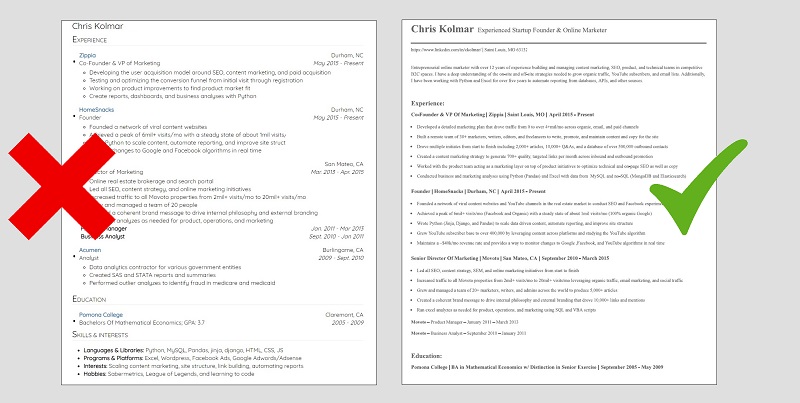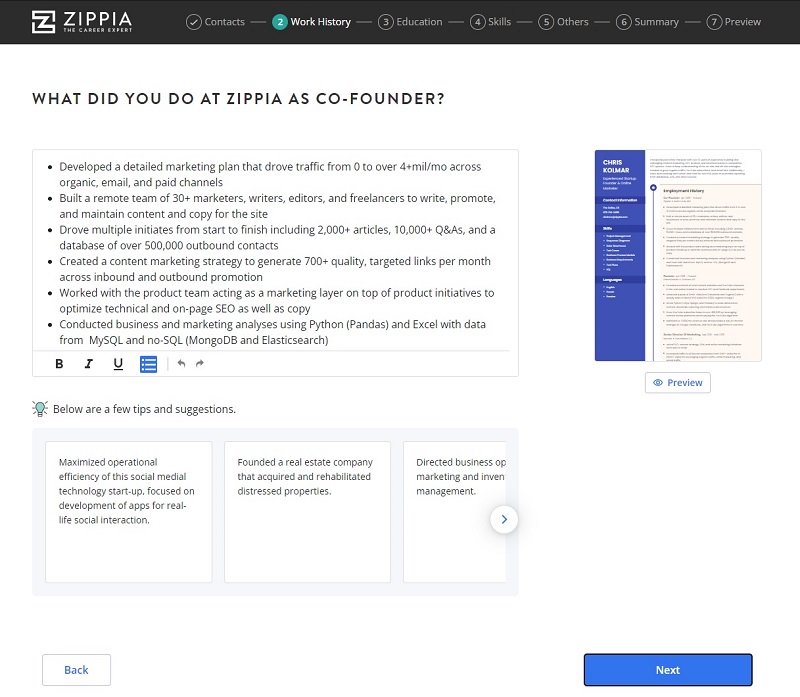- How To Write A Resume
- Resume Examples
- Resume Tips
- Resume Tips
- Best Resume Writing Services
- Things To Avoid On A Resume
- Resume Paper To Use
- What To Include In A Resume
- How To Write A Bio
- How To Write A Personal Statement
- Lied on Your Resume?
- Resume PDF
- Avoid Age Discrimination
- Words and Phrases You Shouldn't Include in Your Resume
- How Many Skills Should You List On A Resume
- Send A Resume As A Pdf
- Resume Critique
- Make A Resume Stand Out
- Resume Spelling
- Resume Past Or Present Tense
- How To List Projects On A resume
- Best Resume Action Words
- How To Quantify Your Resume
- Resume Bullet Points
- Are Resume Writers Worth It
- How Many Jobs To List On Resume
- Resume Vs CV
You’re not sure what your resume needs. It’s boring, a tiny bit cookie-cutter, and you’re not convinced it’s going to get the response you need.
If you can’t be bothered to read through your resume in full, don’t assume someone else will.
Fear not. There is a way to “spice up” your resume and make it easy to read for recruiters, hiring managers, the guy at the bus stop… whoever you want to get in front of.
Quantifying the bulleted information you include can be the difference between a glance and scheduling an interview.
Don’t just take my word for it, though. See it in practice. What sounds better?
“Provided training for new hires” or “Provided training for 25 new hires over 18 months.”
“Managed multiple databases of varying sizes” or “Managed up to five databases holding 1TB of data each.”
Your resume can be bland, or it can stand out. It’s your choice.
I’ll paint you a picture. The recruiter (or hiring manager) is sitting at their desk, combing through resumes. Their wrist is numb, their eyes are tired, and they just want their final list of “yes! Let’s interview this one” so they can move on with their lives.
Yours is just one of the hundreds of applications they have to look through. They don’t have the time to read each of them word-for-word. They’re skimming—and they’re skimming—looking for the right keywords, the right qualifications, the right fit.
Do you think they want to read a novel beneath each of your listed positions? Of course not. So, make things easier for them.
Your resume should be easy to digest. It should be a quick read without dense paragraphs of information.
If you’re doing things right, there should be a bulleted list of your responsibilities and achievements below each of your previously (or currently) held positions. Make them count.
Don’t just droll on about your job duties and vague accomplishments.
Quantify your achievements.
It strengthens your resume and gets the attention of the people who matter most: your potential employers.
Want to save time and have your resume ready in 5 minutes? Try our resume builder. It’s fast and easy to use. Plus, you’ll get ready-made content to add with one click. See 10+ resume templates and create your resume here.

One of users, Diana, had this to say:
I was guided on how to make a detailed and professional resume on Zippia. I was able to download it with unlimited access to all features.
What Does It Mean to Quantify Something?
To quantify means to measure something with numbers. When it comes to your resume, numbers matter.
No matter the role you play, there are quantifiable achievements you can list on your resume. Key performance indicators are measured numerically, for instance.
Quantifying can take something from abstract concept to concrete proof. It shows what you’ve accomplished, what kind of impact you’ve had at your previous companies, which, in turn, shows them what you could potentially accomplish when you work for them.
More importantly, they get the hiring manager’s attention.
The Benefits of Quantifying Your Resume
It is one thing to say you did something and quite another to demonstrate your abilities. Quantifying your accomplishments and responsibilities helps to legitimize them.
The numbers highlight the impact you had, and the results yielded. They add professionalism and build credibility in the eyes of the hiring manager.
Quantifying your resume helps it stand out and shows your potential employer just how qualified you are for this position. In other words, we quantify to qualify.
Update Your Resume Now To Get Your Next Job Faster

How to Choose Your Resume Bullet Points
Sure, it sounds simple. Add some numbers, and boom, your resume will give that recruiter the ol’ razzle-dazzle. Interview landed.
If only.
For some, it may be that simple. Those working in sales or marketing have easily quantified achievements they can list out without much thought.
If your position doesn’t necessarily yield results that are easy to quantify, on the other hand, it can be a little complicated.
There are steps you can take to simplify this process:
-
Brainstorm. The first step is figuring out what you want to include in your resume. Brainstorm a list of potential bullet points for each position you are including.
Try to think of more statements than you’ll need; you’ll be paring the list down as you go on.
You will, of course, need to include your responsibilities. But you should focus on your measurable accomplishments as they pack a bigger punch. Both can be quantified — see below for how.
-
Separate. Next, you’ll need to determine which of your responsibilities and accomplishments could potentially be quantifiable. Which of the listed items can you attach a definitive number to?
It may not be immediately apparent, so don’t rule anything out yet. You just want to identify the most straightforward items to quantify for now. You can go back and worry about the other statements later.
-
Quantify. Time to add your numbers. If you’re not quite sure how to do that, see below. I’ve got you covered.
Expert tip: Use the actual numbers and signs instead of writing them out. Eight percent is not nearly as eye-catching as 8%.
-
Provide context. As tempting as it is to list out a bunch of numbers, you will need to provide a little context for each quantified achievement. Your potential employer needs to understand the impact in addition to the numbers.
Once you have your list of potential bullet points and you’ve identified all the easy to quantify items, it’s time to dig a little deeper.
Remember, you don’t want to toss the bullet points you’re not sure about. Some will still be quantifiable, and the rest may still be necessary. Not every bullet point needs to be quantified. In truth, some couldn’t possibly have a number attached to them.
That doesn’t mean they’re not necessary. You will have to judge what you need to include and what you can leave off. Make sure that you are painting a complete picture of your potential.
How to Quantify Your Resume Bullet Points
There is a relatively simple formula you can use:
Action word + number = quantified achievements
We know from #4 above that there is a little more to it than this; you need to provide context for your numbers. But, this formula describes what you’ll be doing in the simplest of terms.
If you followed the steps above, you’ve focused your attention on your measurable accomplishments. These are accomplishments that are easy to attach a number to.
Measurable accomplishments include:
-
Revenue generation
-
Lead generation
-
Sales growth
-
Closed sales
-
Efficiency
-
Publications
-
Conversions
-
Contracts won
-
Turnover rate
-
Order value
-
Customer acquisition
-
Customer satisfaction
-
Customer retention
-
Expenses
-
Tickets
-
Hold time
-
amp; many more
Don’t write off your responsibilities, though. These, too, are important, and many can be quantified. Your potential employers need a well-rounded view of your experience and potential. That means including duties and achievements for each position, not just one or the other.
Recruiters, hiring managers, and potential employers want to see specific numbers, so get as granular as you can. If you don’t know exact numbers, you can list a range.
You can:
-
Show an increase. Whether you increased sales numbers, employee retention, efficiency, or something else, you can quantify it.
Percentages can accomplish this: “Grew Australian market by more than 200%”.
Or, you can use a numerical increment; remember to provide context: “Increased YTD sales by $2M, surpassing sales goals by 10%”.
-
List a ranking, standing, or award. Achievements, in this case, don’t necessarily have to be numerical. Specific awards can be considered quantifiable achievements. Being the first, last, youngest, etc., still counts.
The context here would be the year you won the award. Employers want to know you still possess the skills to repeat this achievement.
Including an award you received six years ago doesn’t tell them much. Leaving a year off, on the other hand, tells them a whole lot.
-
List frequency. This is a simple way to quantify your responsibilities. Show how often you completed a complicated task.
This can be daily: “Drafted and published four articles per day.”
Weekly: “Completed a full database backup each week.”
Monthly: “Crafted and executed 50 email campaigns per month and generated over $800,000 in revenue over three months.”
Quarterly: “Generated 2,000 new leads in Q3 2021.”
Yearly: “Organized 20 events for 250+ people each and raised over $1M in 12 months.” -
Show volume. This is another way to quantify your responsibilities. You can show the volume of work you completed, the number of employees you supervised, how many accounts you were in charge of, etc.
For example: “Managed 80-100 inbound customer calls per day.”
As the simplified formula mentions above, you will need to include action words with each bullet point. Action words, sometimes referred to as power words, are verbs used to describe your skills, tasks, and achievements.
Your word choice matters greatly here. The right words can help to make the statement more impactful.
Don’t say, “Wrote six white papers that earned 25,000 downloads”.
Instead, say, “Authored six white papers which resulted in 25,000 downloads”.
The second statement is much more powerful. Powerful statements will get you more attention from the hiring managers. Choosing the right action words and quantifying can help make a lasting impression that has the hiring manager reach for the phone.
Action words to include in your resume:
-
Managed
-
Increased
-
Controlled
-
Coordinated
-
Executed
-
Planned
-
Produced
-
Created
-
Designed
-
Established
-
Implemented
-
Incorporated
-
Spearheaded
-
Diagnosed
-
Consolidated
-
Yielded
-
Boosted
-
Amplified
-
Delivered
-
Generated
-
Improved
-
Converted
-
Overhauled
-
Restructured
-
Streamlined
-
Directed
-
Recruited
-
Guided
-
Enabled
-
Acquired
-
Negotiated
-
Advised
-
Resolved
-
Assembled
-
Evaluated
-
Forecasted
-
Identified
-
Tracked
-
Ensured
-
Monitored
-
Verified
-
Attained
-
Reached
-
Succeeded
-
Targeted
-
Merged
-
Partnered
-
Created
-
Delivered
-
Crafted
-
Drafted
-
Maintained
-
Authored
Then again, there’s one more thing you can do.
Make a new resume and get more interviews.
Plus, a great resume will give you an advantage over other candidates. You can write it in our resume builder here. Here’s what it may look like:
Final Thoughts
Your resume and your cover letter are what stand between you and an interview. Your cover letter serves as your introduction, but your resume is what drives potential employers to consider you as a potential candidate.
By quantifying your resume bullet points, you can stand out as an ideal candidate, primarily if you focus on the job duties and achievements that most strongly display your potential in your applying position.
Choose your statements wisely and quantify when it makes sense. Your application will be more robust, and you’ll earn more interviews.
- How To Write A Resume
- Resume Examples
- Resume Tips
- Resume Tips
- Best Resume Writing Services
- Things To Avoid On A Resume
- Resume Paper To Use
- What To Include In A Resume
- How To Write A Bio
- How To Write A Personal Statement
- Lied on Your Resume?
- Resume PDF
- Avoid Age Discrimination
- Words and Phrases You Shouldn't Include in Your Resume
- How Many Skills Should You List On A Resume
- Send A Resume As A Pdf
- Resume Critique
- Make A Resume Stand Out
- Resume Spelling
- Resume Past Or Present Tense
- How To List Projects On A resume
- Best Resume Action Words
- How To Quantify Your Resume
- Resume Bullet Points
- Are Resume Writers Worth It
- How Many Jobs To List On Resume
- Resume Vs CV





